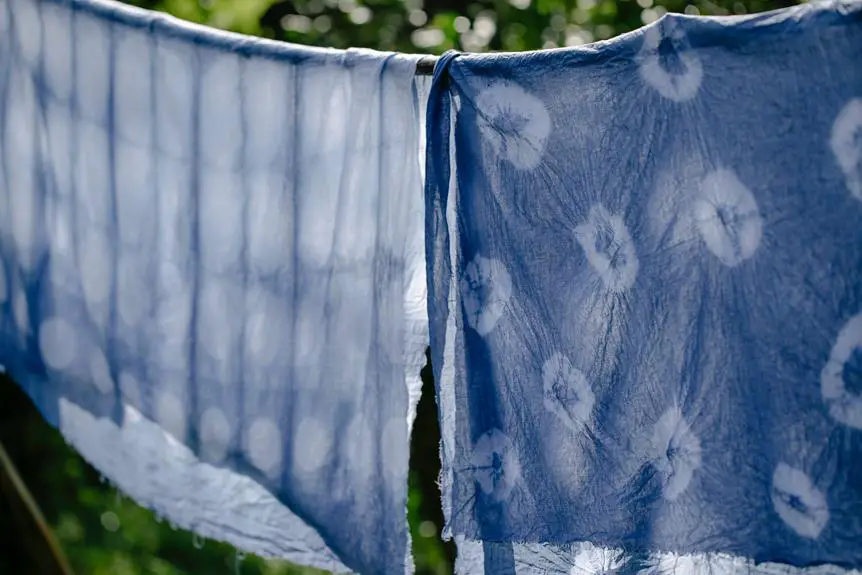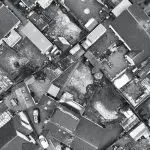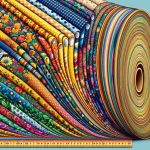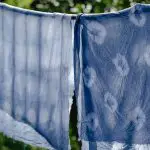Ever wondered how much fabric you need for a project? Picture this: 5 yards of fabric can make a stunning floor-length gown, a cozy quilt, or several stylish throw pillows.
Understanding the length of 5 yards is essential for mastering your sewing and crafting endeavors. You'll discover how to visualize this amount, convert it to other measurements, and estimate yardage for different garment types.
Additionally, you'll gain insights into purchasing the right amount of fabric, optimizing cutting and layout, and properly storing and caring for your 5 yards of fabric.
Get ready to take the guesswork out of fabric measurements and confidently tackle your next creative venture.
Key Takeaways
- Understanding yardage and calculating fabric needs is important for accurate project planning.
- 5 yards of fabric can be used for a variety of sewing or crafting projects, such as curtains, pillow covers, table runners, and quilts.
- Fabric cutting tips include using sharp scissors, aligning pattern pieces with the fabric's grain line, and strategically planning the layout to minimize wastage.
- Converting yards to other units of measurement, such as meters or feet, allows for flexibility in working with different measurement systems.
Understanding Yardage in Fabric Measurements
If you're new to sewing or crafting, understanding yardage in fabric measurements is crucial for accurately planning and executing your projects. Estimating fabric needs and calculating yardage requires a good grasp of fabric measurement techniques.
When you're at the fabric store, the bolts of fabric are typically folded to display a certain width, commonly 45 inches or 60 inches, and then measured and priced by the yard. This is where understanding fabric yardage comes into play.
To estimate the amount of fabric you need for a project, start by consulting the pattern or project instructions. They often provide guidance on the required yardage based on the width of the fabric. If you're working without a pattern, you'll need to calculate the yardage based on the specific measurements of your project.
Knowing how to calculate yardage ensures that you purchase enough fabric without overbuying. This skill becomes increasingly important as you tackle larger projects such as curtains or upholstery.
Visualizing 5 Yards of Fabric
When it comes to visualizing 5 yards of fabric, it can be helpful to compare it to everyday items like a tablecloth or a standard bedsheet.
Understanding the length of fabric can also inspire ideas for different sewing or crafting projects, from making curtains to creating a new wardrobe piece.
Additionally, knowing some cutting tips can maximize the use of 5 yards of fabric and minimize waste.
Fabric Length Comparison
To visualize the length of 5 yards of fabric, gather a measuring tape and a clear open space. Lay out the measuring tape in a straight line to represent 5 yards. Now, let's compare this fabric measurement to everyday objects to better grasp its length.
| Object | Length (Approx.) |
|---|---|
| Car | 15 feet |
| King-sized Bed | 6.25 feet |
| Dinner Table | 8 feet |
Fabric Usage Ideas
After visualizing the length of 5 yards of fabric in comparison to everyday objects, you can now envision various creative ways to use this amount of fabric for your projects.
For fabric scrapbooking, consider using the fabric to create unique backgrounds or embellishments for your scrapbook layouts. You could also use the fabric to make fabric-covered photo frames, personalized fabric bookmarks, or even small fabric pouches to store memorabilia.
When it comes to home decor ideas, 5 yards of fabric can be utilized to make beautiful curtains, throw pillow covers, table runners, or a stylish fabric wall hanging. Additionally, you might consider using the fabric to create custom lampshades, reupholster a chair, or make a cozy quilt for your living space.
The possibilities are endless with 5 yards of fabric at your disposal!
Fabric Cutting Tips
Cutting 5 yards of fabric can seem daunting, but with the right techniques, you can efficiently transform it into your desired pieces for sewing projects. Here are some fabric cutting tips to help you achieve precision and efficiency:
- Use sharp scissors or a rotary cutter: Sharp tools ensure clean and accurate cuts, making your fabric cutting process smoother.
- Follow the grain line: Align your pattern pieces with the fabric's grain line to ensure that your finished garment drapes properly.
- Lay out pattern pieces strategically: By carefully planning the layout of your pattern pieces, you can minimize fabric wastage and maximize efficiency.
- Secure fabric in place: Use pattern weights or pins to secure the fabric before cutting to prevent shifting and ensure precision.
- Cut in a single layer: Cutting one layer at a time allows for better control and accuracy, especially when working with intricate patterns.
These techniques will help you make the most out of your 5 yards of fabric.
Converting Yards to Other Units of Measurement
When measuring fabric, you can easily convert yards to other units of measurement using simple multiplication or division. Converting yards to other measurement units allows for flexibility in working with fabric.
One common conversion is from yards to meters, which is especially useful when dealing with patterns or measurements in the metric system. To convert yardage to meters, multiply the number of yards by 0.9144. For example, 5 yards of fabric is approximately equal to 4.57 meters (5 yards x 0.9144).
Similarly, to convert yards to feet, simply multiply the number of yards by 3. For instance, 5 yards of fabric equals 15 feet (5 yards x 3).
Understanding yardage conversion enables you to adapt to different measurement systems and work with fabric based on your specific project's requirements. Whether it's meters for an international pattern or feet for a local project, being proficient in yardage conversion allows you to navigate various measurement units effectively, making fabric cutting and usage more precise.
How 5 Yards Compares to Common Sewing Projects
When it comes to common sewing projects, 5 yards of fabric can go a long way. For basic garments like skirts and tops, 5 yards is usually more than enough.
However, if you're working on a project that requires draping or flowy designs, 5 yards can provide the necessary fabric for these more intricate pieces.
Yardage for Basic Garments
When sewing basic garments, 5 yards of fabric can be sufficient for making a dress or a skirt, depending on the length and fullness of the design.
For instance, with 5 yards of fabric, you can create:
- A knee-length, A-line skirt with a simple waistband and minimal gathering.
- A sleeveless, knee-length shift dress with a straight silhouette.
- A midi-length, flared skirt with pleats or gathers at the waist.
- A short-sleeved, knee-length wrap dress with a moderate amount of fabric for the skirt.
- A sleeveless, maxi dress with a slim-fitting bodice and a slightly flared, floor-length skirt.
Considering yardage estimation and fabric utilization is crucial when planning these garments, as variations in design and size can greatly impact the amount of fabric needed.
5 Yards for Draping
As you drape fabric, you'll find that 5 yards provides ample material for creating elegant and flowing designs. When using draping techniques, the fabric drape analysis is crucial to achieving the desired look.
For instance, a simple draped dress might require approximately 3-4 yards of fabric, while a flowing maxi dress could necessitate up to 5 yards for a fuller, more dramatic effect. Additionally, creating a gathered or pleated effect in your drapery will also impact the yardage needed.
For example, a gathered bodice or full, voluminous sleeves will require more fabric for proper draping. Understanding how 5 yards of fabric compares to common sewing projects allows you to confidently experiment with draping techniques, ensuring that you have enough material to achieve the desired fluidity and drape in your designs.
Estimating Yardage for Different Garment Types
To estimate yardage for different garment types, calculate the required amount based on the specific measurements of the pattern you plan to use. Consider the following when estimating yardage for different garment types:
- Silhouettes: Take into account the fullness and length of the garment to determine the necessary yardage accurately.
- Fabric Width: Depending on the fabric width, the yardage required will vary, so always check the pattern envelope for the specific fabric width requirements.
- Pattern Repeats: For patterned or striped fabrics, you may need extra yardage to match the prints or stripes correctly.
- Garment Details: Additional yardage might be needed for features such as ruffles, pleats, or directional prints.
- Lining and Interfacing: Don't forget to account for yardage needed for lining or interfacing, if required, in addition to the main fabric.
When estimating yardage for different garment types, understanding the fabric types, yardage estimation, and garment construction is crucial for an accurate calculation. By considering these factors, you can ensure that you purchase the correct amount of fabric for your chosen garment, minimizing waste and avoiding last-minute fabric shortages.
Tips for Purchasing the Right Amount of Fabric
Make sure to assess the pattern's fabric requirements and your personal measurements before purchasing the fabric. This will help you determine the right amount of fabric to buy, ensuring that you have enough for your project without overspending. When choosing fabric, consider the weight and drape that the pattern recommends. For example, a lightweight, flowy fabric may require more yardage than a heavier, more structured fabric due to the way it drapes and gathers.
Consider pattern matching as well. If the fabric has a distinct pattern or print, you may need to purchase extra yardage to ensure that the pattern aligns correctly at the seams. Additionally, calculating yardage can be simplified by using the table below to estimate the amount of fabric needed based on common garment types:
| Garment Type | Fabric Yardage |
|---|---|
| Blouse | 2-3 yards |
| Dress | 3-4 yards |
| Pants | 2-3 yards |
Making the Most of 5 Yards: Cutting and Layout
When working with 5 yards of fabric, maximize its use by considering the pattern's fabric requirements and your personal measurements. To make the most of your fabric, employ these cutting techniques and fabric layout strategies:
- Efficient Pattern Placement: Lay out pattern pieces strategically to minimize fabric waste and ensure all pieces fit within the 5-yard constraint.
- Directional Layout: Consider the fabric's print or pattern direction when laying out pattern pieces to achieve a cohesive and visually appealing garment.
- Cutting on a Single Layer: For more precise cutting and to conserve fabric, consider cutting pattern pieces on a single layer of fabric at a time.
- Strategic Grainline Placement: Align pattern pieces with the fabric's grainline to ensure proper drape and garment structure, optimizing the use of fabric yardage.
- Use of Remnants: After cutting out pattern pieces, assess if any remnants can be utilized for smaller garment components, such as pockets, facings, or bias tape.
Properly Storing and Caring for 5 Yards of Fabric
Ensure your 5 yards of fabric remain in optimal condition by storing them in a cool, dry place away from direct sunlight and moisture. Proper folding is essential to prevent creases and wrinkles that can be difficult to remove. When folding your fabric, avoid sharp creases by gently rolling it onto a fabric bolt or acid-free cardboard tube to maintain its smoothness. Additionally, consider storing your fabric in a breathable cotton storage bag to protect it from dust and allow air circulation.
Moisture prevention is crucial in preserving the quality of your fabric. Utilize moisture-absorbing products such as silica gel packets or charcoal deodorizers in the storage area to safeguard the fabric from dampness. Regularly inspect the storage space for any signs of moisture or mildew, and address any issues promptly to prevent damage to the fabric.
Frequently Asked Questions
Can 5 Yards of Fabric Be Used to Make a Full-Length Gown or Dress?
Yes, 5 yards of fabric can be used to make a full-length gown or dress. With proper sewing techniques and strategic fabric lengths, you can create a stunning garment that is both fashionable and elegant.
How Many Standard Pillowcases Can Be Made From 5 Yards of Fabric?
You can make approximately six standard pillowcases from 5 yards of fabric. This is based on standard pillowcase measurements and fabric yardage limitations. So, with 5 yards of fabric, you can easily create a set of cozy pillowcases.
Are There Any Specific Fabric Types or Patterns That Require More or Less Than 5 Yards for a Project?
When choosing fabric types and patterns for your project, consider the variations in project requirements. Some fabrics may require more or less than 5 yards due to their thickness, pattern repeat, or width.
What Are Some Creative Ways to Use Leftover Fabric After a 5-Yard Project?
Looking for creative ways to use leftover fabric after a 5-yard project? Consider upcycling projects like making fabric art, DIY gifts, or repurposing fabric scraps for smaller crafts. There are so many possibilities!
Can 5 Yards of Fabric Be Enough for Upholstery or Large Home Decor Projects?
For upholstery or large home decor projects, 5 yards of fabric yardage should be sufficient. Consider the specific dimensions and design of your project, but this quantity is often suitable for various home decor and upholstery endeavors.
- Jute Fabric Sofa Designs: Inspiration for Your Living Room - June 29, 2025
- Jute Fabric Sofa Designs: Inspiration for Your Living Room - June 29, 2025
- Jute Fabric Sofa Designs: Inspiration for Your Living Room - June 29, 2025







